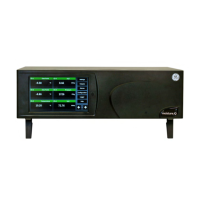
Do you have a question about the GE moisture.IQ and is the answer not in the manual?
| Brand | GE |
|---|---|
| Model | moisture.IQ |
| Category | Analytical Instruments |
| Language | English |
Register product for support, upgrades, and promotions.
Offers training, product repairs, extended warranties, and service agreements.
Information on sales terms, conditions, and warranty.
Explains notes and important information formatting.
Explains CAUTION and WARNING symbols and safety regulations.
Guidelines for operating auxiliary equipment and safety.
Compliance with RoHS and WEEE directives.
Overview of installation into process systems and environmental factors.
Instructions for unpacking, inspecting, and reporting damage.
Guidance on installing the unit, including safety warnings.
Guidelines for selecting an optimal installation location.
Factors affecting probe performance and life, including handling and environment.
Guidelines for designing sample systems for moisture and oxygen measurement.
Instructions for mounting the electronics unit, probes, and sample systems.
Steps for inserting moisture probes into sample cells and connecting oxygen cells.
General instructions for making electrical connections, including safety warnings.
Procedures and cautions for establishing gas flow through the Delta F Oxygen Cell.
How to power and connect auxiliary devices to the moisture.IQ.
Connecting analog outputs to terminal blocks for recorders.
Details on connecting alarm relays, including pin designations.
Sequence of screens observed when powering up the moisture.IQ.
Description of items on the measurement display screen.
Accessing context-sensitive help information from any screen.
Configuring individual data measurements using the Data Element Editor.
Steps for initial configuration of the moisture.IQ and attached probes.
Procedure to restart (reboot) the moisture.IQ system.
Procedure for safely shutting down the moisture.IQ system.
Overview of configuring the moisture.IQ for data collection.
Configuring the measurement screen, including items and brightness.
Configuring global settings like date, time, and number format.
Viewing and managing files stored in memory or on a USB drive.
Calibrating the LCD screen for optimal touch performance.
Adjusting touch screen sensitivity and orientation.
Specifying how often calibration reminders are displayed.
Configuring the fault alarm relay response and listing fault sources.
Viewing installed sensor module information and firmware versions.
Accessing software updates, restarts, and shutdown options.
Configuring analog outputs for channels, including mode, unit, and span.
Detailed steps for configuring analog output channels (A and B).
Steps to test output devices connected to the moisture.IQ.
Compensating for load resistance variations in output signals.
Configuring how outputs respond to under or over range errors.
Configuring optional alarms (A and B) for each channel.
Steps to set up alarm modes, units, and setpoints.
Testing alarm functionality by tripping and resetting them.
Configuring alarm responses to under or over range errors.
Setting up and controlling data logging functions.
Programming the moisture.IQ with probe measurement types and activating probes.
Activating installed probes on each channel and selecting measurement modes.
Selections available for Delta F Oxygen Sensor probes.
Steps for calibrating individual channels using dummy probes.
Setting the frequency for the probe's automatic calibration function.
Procedures for entering calibration data for probes.
Automatically entering calibration data from files.
Manually entering calibration data points from sheets.
Assigning custom tags to input parameters for display customization.
Entering user-defined information like functions, tables, and constants.
Programming mathematical equations on each channel.
Creating up to six tables of non-linear data for user-defined functions.
Substituting user-defined constants for measurements and applying multipliers.
Entering saturation values (Cs) for ppmw moisture calculations.
Checking and replenishing electrolyte in the oxygen cell due to gradual water loss.
Using the level indicator window to check the electrolyte level.
Instructions for adding distilled water to replenish the electrolyte.
Recommended frequency for sending probes for recalibration.
Steps for calibrating the Delta F Oxygen Cell, including displaying content and checking calibration.
Determining the channel and configuring display for oxygen data.
Procedure to check oxygen cell calibration using calibration gas and a formula.
Recalibrating for background gases other than nitrogen.
Deriving correction factors for gases other than nitrogen.
Listing screen messages, possible causes, system responses, and actions.
Troubleshooting common issues with moisture sensor accuracy and response.
Intrinsic safety, inputs, auxiliary inputs, and analog/alarm outputs.
Type, calibration ranges, accuracy, repeatability, and operating pressure.
Type, calibration ranges, and accuracy for temperature measurement.
Type, available ranges, accuracy, and pressure rating.
Type, available ranges, accuracy, and pressure rating.
Display, temperature, warm-up time, and data logging details.
Analog/digital outputs, alarm relays, and output updating details.
Input capability, resolution, probe/sensor types, and intrinsic safety.
Specifications for Moisture Image Series and M Series probes.
Visual representation of the Settings menu structure.
Visual representation of the Outputs, Alarms, and Logger menu structure.
Visual representation of Configuration menu for Probes and User settings.
Visual representation of Configuration menu for Communications settings.
Wiring details for terminal blocks and rear view of the unit.
Diagrams showing different channel configurations on the rear view.
Wiring diagrams for power connections to the unit.
RS-485 wiring diagram for communication.
Steps to update the main chassis firmware using a USB flash drive.
Loading and plugging in the USB flash drive for module firmware update.
Table detailing Modbus registers for error, analog outputs, and channels.